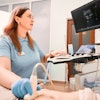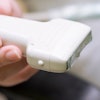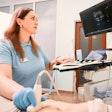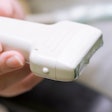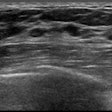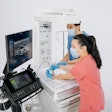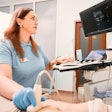A focused ultrasound technique can let specific molecules penetrate the blood-brain barrier, potentially paving the way for treatment of central nervous system diseases such as Parkinson's and Alzheimer's, according to researchers from Columbia University.
In a study published in the Journal of Cerebral Blood Flow & Metabolism, senior author Elisa Konofagou, PhD, shared how acoustic pressure from the focused ultrasound method could -- for the first time -- control the size of the opening of the blood-brain barrier.
While other researchers have found that focused ultrasound in combination with microbubble cavitation can successfully deliver therapeutic drugs across the blood-brain barrier, almost all of these studies have been limited to one specific-sized agent that's commercially available and widely used clinically as ultrasound contrast agents, according to Columbia.
Konofagou and colleagues believed, however, that there was a way to induce a size-controllable opening in the blood-brain barrier, which would yield a more effective way to improve localized delivery of brain drugs (J Cereb Blood Flow Metab, July 2014, Vol. 34:7, pp. 1197-1204).
After targeting the hippocampus and administering different-sized sugar molecules, Konofagou found that higher acoustic pressures led to larger molecules accumulating into the hippocampus, as confirmed by fluorescence imaging. This means that the pressure of the ultrasound beam could be adjusted depending on the size of the drug that needs to be delivered into the brain; all molecules of variant sizes were able to penetrate the opened barrier at distinct pressures, according to the researchers.
Konofagou and her Ultrasound Elasticity Imaging Laboratory team plan to continue to work on the treatment of Alzheimer's and Parkinson's in a range of models, and hope to test their technique in clinical trials within the next five years, according to Columbia.
